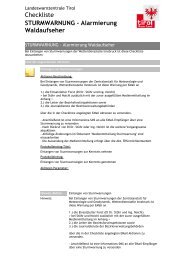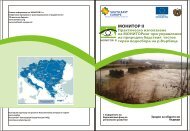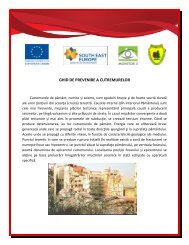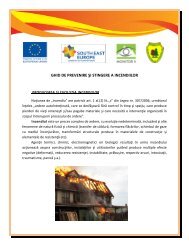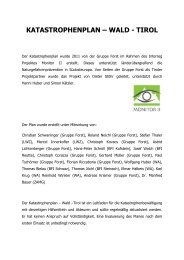risk management - monitor ii
risk management - monitor ii
risk management - monitor ii
Create successful ePaper yourself
Turn your PDF publications into a flip-book with our unique Google optimized e-Paper software.
16 Monitor II Floods and landslides<br />
Monitor II Hazard maps 17<br />
Debris flow<br />
Source area<br />
Main track<br />
Depostional area<br />
Figure 13: Landslides – flows (courtesy USGS).<br />
Creep<br />
Earth flow<br />
Debris avalanche<br />
Lateral spread<br />
also commonly mobilize from other types of<br />
landslides that occur on steep slopes, are nearly<br />
saturated, and consist of a large proportion<br />
of silt- and sand-sized material. Debris-flow<br />
source areas are often associated with steep<br />
gullies, and debris-flow deposits are usually<br />
indicated by the presence of debris fans at<br />
the mouths of gullies. A debris avalanche is a<br />
variety of very rapid to extremely rapid debris<br />
flow. Earthflows have a characteristic<br />
”hourglass” shape. The slope material liquefies<br />
and runs out, forming a bowl or depression<br />
at the head. The flow itself is elongate and<br />
usually occurs in fine-grained materials or<br />
clay-bearing rocks on moderate slopes and<br />
under saturated conditions. A mudflow is an<br />
earthflow consisting of material that is wet<br />
enough to flow rapidly and that contains at<br />
least 50 percent sand-, silt-, and clay-sized<br />
particles.<br />
Landslide – creep, lateral spread<br />
Creep is the imperceptibly slow, steady, downward<br />
movement of slope-forming soil or rock.<br />
Movement is caused by shear stress sufficient<br />
to produce permanent deformation, but too<br />
small to produce shear failure. Creep<br />
is indicated by curved tree trunks, bent fences<br />
or retaining walls, tilted poles or fences, and<br />
small soil ripples or ridges. Lateral spreads are<br />
distinctive because they usually occur on very<br />
gentle slopes or flat terrain. The dominant<br />
mode of movement is lateral extension<br />
accompanied by shear or tensile fractures.<br />
The failure is caused by liquefaction, the<br />
process whereby saturated, loose, cohesion less<br />
sediments (usually sands and silts) are<br />
transformed from a solid into a liquefied state.<br />
The tools: state-of-the-art<br />
A major goal of the MONITOR II project is to contribute to the definition of a harmonised<br />
methodology for hazard mapping and contingency planning within the EU-member states, based<br />
on the experiences of the organisations participating in MONITOR II. Based on the state-of-the-art<br />
analysis and evaluation of hazard mapping and contingency planning practices prevailing in the<br />
participating countries and organisations, recommendations for improvement, harmonisation and<br />
adaptation of existing hazard maps and contingency plans were worked out.<br />
Be informed – hazard maps<br />
The process of hazard assessment<br />
Starting point of hazard assessment is a<br />
situation of threat, for which hazard assessment<br />
is a recommended (or in some cases:<br />
a legally prescribed) measure. The goal of<br />
hazard assessment is to define hazard potential<br />
(qualitative as well as quantitative).<br />
Activities in hazard assessment execution<br />
are carried out according to methods (rules,<br />
guidelines, practice…). These methods can be<br />
seen as a knowledge source for successfully<br />
reaching the goal defined for a plan. Subplans<br />
of hazard assessment are hazard inventory,<br />
hazard analysis and hazard evaluation with<br />
each having a related goal.<br />
Hazard maps can generally be described as<br />
a major output of hazard assessment and<br />
constitute a decisive element in <strong>risk</strong> <strong>management</strong>.<br />
They assist the identification, evaluation<br />
and reduction of <strong>risk</strong> by using an optimal<br />
combination of measures. In a general<br />
definition the term hazard map encompasses<br />
both the map proper and all the expertise.<br />
Hazard assessment thus covers hazard<br />
inventory AND hazard analysis AND hazard<br />
evaluation.<br />
Hazard inventory: Is the identification and<br />
description of existing and potential hazards<br />
and the general conditions (physical –<br />
meteorological - ....) that determine them.<br />
Tilted pole<br />
Soil ripples<br />
Bedrock<br />
Firm clay<br />
Hazard analysis: Is the (qualitative, semiqualitative<br />
or quantitative) description of<br />
the probability of the event and its spatiotemporal<br />
location and magnitude (intensity).<br />
This involves measurement of parameters and<br />
estimation (by modeling approaches) and interpretation<br />
of data.<br />
Curved tree trunks<br />
Fence out of alignment<br />
Figure 14: Landslides – creep and lateral spread (courtesy USGS).<br />
Soft clay with water-bearing<br />
silt and sand layers<br />
Figure 15: Hazard assessment and related goals (S. KOLLARITS et al. 2007)<br />
Within hazard analysis one (or more) likely<br />
scenarios of hazard process development are<br />
being considered. They serve as the central<br />
input to hazard evaluation.



